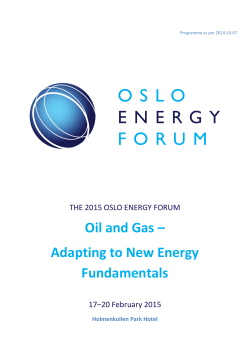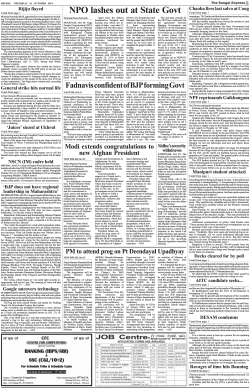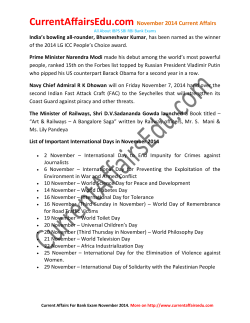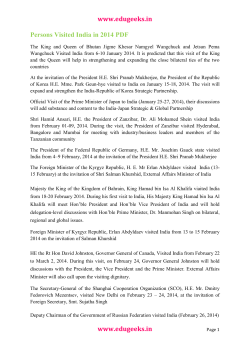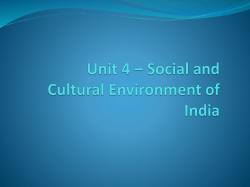
Honourable and acceptable final settlement of Indo-Naga Peace Talk
IMPHAL MONDAY 10 NOVEMBER 2014 IMPHAL MONDAY 10 NOVEMBER 2014 Honourable and acceptable final settlement of Indo-Naga Peace Talk Dr Khomdon Lisam Today's Thought Conscience is the inner voice that tells us that someone may be looking. HL Mencken. Ettiquette of inviting the PM No official response till date It is official. Prime Minister Narendra Modi is set to take part in the Hornbill Festival at Nagaland on December 1. It is unofficial but most likely the Prime Minister too is likely to attend the closing day of the Sangai Festival at Imphal on November 30. An observation based on a report from Delhi which stated that the Prime Minister is scheduled to visit Guwahati for the DGP conference and then proceed to Manipur and Nagaland. The ‘unofficial’ part is based on the same report which has so far not said anything about the Prime Minister attending the closing day of the Sangai Festival but which co-incides with his visit here one day before he is set to visit Nagaland. This much has been spelt out clearly in the report which was carried in a Kolkata/Guwahati daily prominently a few days back. If Mr Modi is here on the last day of the Sangai festival then in all probability he will make it a point to attend the closing day of the State level festival here. A feather in the cap of Chief Minister O Ibobi, by default, if one may add. Much before any news of the Prime Minister’s itinerary was heard here, the State Government had made it clear that an invitation would be extended to the Prime Minister, either on the opening day of the festival on November 21 or the closing day on November 30. From the announcement of the State Government it became public knowledge that the Prime Minister has indeed been invited to attend the Sangai Festival. That was the last thing that was officially heard. No word on whether the Prime Minister had accepted the invitation or not and it was only a couple of days back that news was received that the Prime Minister will indeed be visiting Manipur on November 30, as part of his plans to visit the North East States. No official report on whether the Prime Minister is going to attend the Sangai Festival or not, but more than clear that he will be here on November 30. Not yet explained but there must surely be a reason why nothing official has been said on the invitation to the Prime Minister, though he has officially accepted the invitation from the Government of Nagaland to attend the Hornbill Festival. In the absence of anything official from the office of the Prime Minister, it would be premature to say anything but it is nonetheless important to keep certain things in mind. In the first place, the importance of the Prime Minister’s Office must be kept in mind. Invitations may be sent, but it is equally important to keep in mind that the manner in which the invitation is extended is not something which can be done casually. A point borne out by the fact that Nagaland Chief Minister TR Zeliang personally extended the invitation to the Prime Minister at Delhi. Not sure why such an example was not followed here. What stopped Chief Minister O Ibobi from personally inviting the Prime Minister ? Inviting the Prime Minister through a third or second party is certainly not an ideal way of inviting the first among equals of the Lok Sabha and Parliament. Etc.. etc... WHO launches new guidelines on management of latent TB infection Shobha Shukla, Citizen News Service (CNS) The following treatment options are recommended for the treatment of LTBI in the guidelines: (i) isoniazid daily for 6 months (6H) (ii) isoniazid daily for 9 months (9H) (iii) the combination of rifapentine and isoniazid once a week for 12 weeks (3HP) (iv) the combination of rifampicin and isoniazid daily for 3-4 months (3-4HR) (v) rifampicin alone daily for 3-4 months (3-4R) “Currently, these are the only diagnostic tests available though they are both weak in predicting future development of TB among infected. Development of better diagnostic tools should be priority for research’ said Dr Alberto Matteelli, Medical officer from the TB/HIV and community engagement unit. In addition, the Guidelines Development Panel noted the following critical issues for consideration in the implementation of these guidelines: * Strict clinical observation and close monitoring for the development of active TB disease among contacts of multidrug-resistant TB (MDR-TB) cases, preferably for at least two years over the provision of preventive treatment; * Regular clinical monitoring of individuals receiving treatment for latent TB through a monthly visit to the health-care provider; * Establishment of national TB drug resistance surveillance systems while implementing national latent TB management services; * Introduction of flexible interventions and incentives by national TB programmes that are responsive to the specific needs of population groups at risk, as well as tailored to the local context and their needs to ensure acceptable initiation of, adherence to and completion of LTBI treatment. * Documentation of treated individuals through a functional, routine monitoring and evaluation system that is aligned with national patient monitoring and surveillance systems. * Creation of conducive policy and programmatic environment, including the promotion of universal health coverage, development of national and local policies, standard operating procedures, as well allocation of dedicated resources. (To be contd) Once Alexander, the great said “I am not afraid of an army of lions led by a sheep; I am afraid of an army of sheep led by a lion”. We are happy to hear that a 10-member team of the NSCN-IM including Isak Chishi Swu, Chairman and Thuingaleng Muivah, General Secretary is meeting the Prime Minister of India, Shri Narendra Modi to find an honourable and acceptable final settlement of Indo-Naga Peace Talk. The Narendra Modi-led NDA government had appointed the Chairman of the Joint Intelligence Committee (JIC), R N Ravi, as the new interlocutor for talks with NSCN-IM. But it will be too much to expect for any tangible result this time due to absence of other stakeholders comprising of representatives of Assam, Arunachal Pradesh and Manipur and lack of clarity of the demands of NSCN-IM. Mr. Isak Chishi Swu, Chairman, NSCN-IM and Thuingaleng Muivah, General Secretary are camping at Hebron since 18 October, 2012 for a “home consultation” with various civil societies and other factions to reach an honourable and acceptable final settlement of IndoNaga Peace Talk. On 18 Oct, 2014, Mr. Ajit Doval, National Security Adviser said “An early and a result-oriented end to talks with Naga insurgent group NSCN-IM is required for restoring the rule of law in the troubled northeastern state of Nagaland .” We want Manipur to be a safe place for our future generations, We want Manipur to be free from communal conflicts, communal dis-harmony and disunity. We should look forward to a strong united Manipur which can compete with any civilized nation of the world. We should work for solidarity and unity of all Manipuris irrespective of political affiliations, religions caste or creed. Manipur belongs to Nagas, Kukis, Meiteis, and Meitei Pangans. We should not allow ourselves to be used as pawns by an outside force to fight against each other. To this end, Mr. Isak Chishi Swu and Thuingaleng Muivah have great responsibilities for ensuring a peaceful North East. The history of Naga National movement is a long and tragic history. The Nagas have suffered to the extreme and have made great sacrifices to achieve Independence. We have all the sympathies, love and admiration for such a long and protracted struggle for independence or self determination in which thousands of lives have been sacrificed. Some of the remarkable events were as follows :Remarkable Events 1. In 1866, a part of the Naga Hills under the British Indian control was coalesced into a district. In 1875, a subdivision was opened at Wokha to exercise control over the Lhota Nagas. In 1878, it was decided to transfer the headquarters of the district to Kohima in the heart of Angamese country. 2. In 1918, after returning of 4000 Nagas from World War-I in France, twenty Nagas including few government officials and leading Naga chiefs formed an organisation known as the “Naga Club” at Kohima for promoting the interests of the Nagas. The Club was informally supported by local British administrators and Christian missionaries. 3. On 10th January, 1929, twenty Naga representatives submitted a memorandum to the Simon Commission under the Chairmanship of Sir John Simon which was boycotted by the people of India to consider the political reforms for independence of Nagas based on “unique history of Nagas.” Under the Government of India Act 1935 which was passed on the recommendations of the Simon Commission the “Naga Hills District” was declared to be treated as “Excluded Areas” on March 3, 1935 4. On 13th November, 1941, Robert Nail Rides, Governor of Assam announced in Shillong that “a direct British ruled crown colony would be formed with the Kachin state of Northwestern Burma and India’s Northeastern hill areas and the planning is on process.” But this could not be materialized due to “Quit India movement” launched on 8 August 1942, by Indian National Congress leading to arrest of 100,000 persons and killing of 1000 volunteers without producing any tangible results 5. In a memorandum presented to the British Government in June 1945, the Naga National Council (NNC) demanded an autonomous status for the Naga region. When the report of the 1946 Cabinet Mission to India was published, NNC passed a resolution on 19 June 1946 at Wokha in Mokokchung division. It stated that it was against grouping of Assam in Bengal, and wanted the Naga Hills District to be included in an autonomous Assam in the independent India. It further emphasized local autonomy for the Naga Hills District, and a separate electorate for the Naga tribes. 6. In November 1946, Gopinath Bardoloi, the Permier of Assam visited the district. In February 1947, the NNC council passed a resolution at Kohima. As a result of this resolution, on February 20, 1947, it submitted a proposal for interim Government of Nagas, under a “Guardian Power” for a period of ten years. They didn’t explicitly state who the “Guardian Power” should be (Government of India or the Provincial Government or His Majesty’s Government). In 1947, the Bardoloi sub-committee came to Kohima for discussions with the Naga leaders. The Bardoloi subcommittee was constituted with Mayangnokcha Ao as a member, but he did not accept the position. Hence, Aliba was taken in his place. 7. On 27 June, 1947, a nine point agreement was signed between NNC and Sir, Akbar Hydari, the Governor of Assam. Within three days, the Naga public rejected Sir Hydari’s agreement. Sir Hydari threatened the Nagas with military might in presence of Sir Pawsey, Deputy Commissioner and others. 8. On 16 May, 1951, a Naga plebiscite was inaugurated. and it took six months to complete . On 29 December, 1951, A.Z Phizo, leader of NNC informed Jawaharlal Nehru about the verdict of the Plebiscite. The NNC claimed that 99 per cent of the Naga people supported a referendum to secede from India, which was summarily rejected by the government of India . 9. On 7th August, 1952, Jawaharlal Nehru declared in the Indian Parliament that “We want no forced marriages or forced unions. This great republic of India is a free , voluntary, friendly and affectionate union of the States of India”. But the examples of Kashmir, Hyderabad, Junagadh and Manipur were neither based on free, voluntary, friendly and affectionate union nor on non-violence. 10. On March 30, 1953, Jawaharlal Nehru with his daughter, Indira Gandhi visited Kohima along with the Burmese Prime Minister U.Nu and was greeted with derision. This was followed by an even more impressive “walk out” protest by ten thousand Nagas from a meeting convened and addressed by Prime Ministers Nehru and U.Nu. A civil disobedience campaign was launched. 11. On 25 March, 1955. the fighting with the armies of the Government of India began in Naga hills. 12. On March 22, 1956, the N.N.C. set up its government– the Federal Government of Nagaland (FGN) and hoisted the republic’s flag. Within two months, it raised a standing army called “Naga Safe Guards”. The N.N.C. activists also formed the Naga Home Guard (NHG) and an underground Parliament called “Tatar Hoho”. The Naga government was strongly supported by the Burmese Communist Party. It shot down an Indian Air Force transport aircraft on a supply dropping mission and the crew were held hostage for many years. Soon large–scale violence erupted throughout Naga Hills . 13. On April 11, 1962, the President of India issued the Nagaland Security Regulation, 1962, for the suppression of subversive activities, maintenance of essential supplies and services and control of military requirements. 14. In August 1962, Nehru moved in Parliament the Bills for the 13th amendment of the Constitution and for the creation of the state of Nagaland. The Bill was given assent by the President on September 4, 1962 merging Naga Hills with Tuensang Division to create the state of Nagaland in 1963. 15. On 1 December, 1963, President Radhakrishnan inaugurated the State of Nagaland at Kohima. Mr. P. Shily Ao became the Chief Minister and declared the occasion “a day of rejoicing” and “the day to redeem our pledge”. The Indian government viewed the Naga problem seriously, and declared the N.N.C., Federal Government of Nagaland and its army “unlawful associations” under the Unlawful Activities (Prevention) Act, 1967 on 31 August, 1972. 15. On 11 November, 1975, the “Shillong Accord” was signed between the Government of India and the N.N.C. Under this agreement, the NNC had agreed to accept the solution of the Naga problem within the framework of the Indian Constitution, abjure violence, bring out the armed men to surrender weapons and resolve the residual problems through discussions. (To be contd) Uninformed outrages won’t bring in criminal justice reform Avinash Pandey “Forceful sex on menopausal woman not rape-Delhi High Court” read a news item (title changed now though the URL remains the same) on one media group website. “Delhi High Court Says ‘Forceful Sex’ Wasn’t Rape”, cried another news outlet. Together, the media coverage on the case has opened the floodgates for the ever ready to get outraged personalities on social media. It is just that Delhi High Court has not said anything even remotely close to what the media has reported. What is more, most of those seething with anger appear not to have read the judgment, easily accessible on the High Court website. All that the Delhi High Court has stated, while upturning a lower court’s decision in the alleged rape and murder case, is that the evidence does not prove “beyond reasonable doubt that the appellant committed sexual intercourse with the deceased contrary to her wishes or her consent.” The uninformed outrage both on social and traditional media has not even touch this most crucial part. No one has asked whose job it is to prove guilt beyond reasonable doubt? It is certainly not that of the Judiciary, is it? Faced with such a situation, Indian jurisprudence, or any sane jurisprudence for that reason, cannot convict without guilt being proven beyond reasonable doubt. No one has cared to ask the prosecution and investigation why there was no evidence – as it can be inferred by a thorough reading of the judgment – other than an autopsy report and the exhibits collected from the incident site. No one amongst the outraged population has asked whether the investigators found a motive behind the alleged murder. The fact that the autopsy found the death to have been caused by internal choking, with the accused having no intent or even awareness of such an eventuality, too was ignored. That motive is often the most decisive factor in sentencing in virtually all jurisprudence appears to be too much detail for the outraged to handle. The only thing scrutinised in detail is the use of the word “menopause”. The section of the judgment carrying the word reads as follows: “As regards the offence punishable under Section 376 IPC the deceased was aged around 65-70 years, thus beyond the age of menopause. We find force in the conten- tion of the learned counsel for the appellant that even if the sexual intercourse was forceful it was not forcible and contrary to the wishes and consent of the deceased. From the MLC of Achey Lal and the post-mortem of the deceased it is evident that both Achey Lal and deceased had consumed alcohol. The forceful penetration is evident from the injuries on the vaginal orifices. However, besides the injuries on the vagina there is no other injury mark on the body of the deceased or on the appellant to show that there was any protest by the deceased. Hence we are of the opinion that it has not been proved beyond reasonable doubt that the appellant committed sexual intercourse with the deceased contrary to her wishes or her consent. Consequently the appellant is also acquitted of the charges under Section 376 IPC. The impugned judgment of conviction and order on sentence are set aside.” It is true that the bench has not explained the use of the term, menopause. It is also true that the bench could have avoided the term altogether. But, it is also clear from the judgment itself that the bench has not stated what many news stories have implied. The media has picked on the term, coupled it with a play of words between “forceful” and “forcible” and cobbled together a headline tacky enough to catch eyeballs, for which media groups battle fiercely nowadays. This is true in most cases – those that stir public conscience and those that meet with public apathy. Unfortunately, while the bulk of the bogey of hurt sentiments and outraged hearts come from rightwingers, civil society also keeps falling prey to the game. Going back to the judgement, is acquitting the accused for want of evidence wrong? Will justice be better served by punishing people even if there is no evidence against them? To put it differently, weren’t the same people so outraged, rightfully in that case, with the death sentence meted out to Afzal Guru purely on the basis of circumstantial evidence which did not prove the guilt beyond reasonable doubt? The judges cannot convict a person for satisfying ‘public conscience’ be it in Afzal Guru’s case or this one. It is time, perhaps, to realize that such outrages can stir people, but justice is done in courts on the basis of evidence, not on the basis of public opinion. And, this is where our police fails more often than not. One may recall the oft-quoted Sessions Court judgment in the Priyadarshini Mattoo murder case, where the judge observed that he was certain that the accused was “the man who committed the crime," but was forced to acquit the accused for want of evidence, lashing out at the Central Bureau of Investigation for its shoddy investigation. The judgment, in fact, went to the extent of pointing out how the personnel of Delhi Police helped the culprits instead of bringing justice to the victim’s family. One may also recall how justice was first denied and then achieved in the Jessica Lal murder case. It was because of investigation that justice was served. Sadly, reforming the criminal justice system does not seem to be a priority for civil society. This is despite the criminal justice system often being the point of first contact between the citizenry and the state; this is despite the system being the first point of denial of justice for citizens, especially the poor and the marginalised ones. Think of the shady role the police has often been found to play, even in sensational cases under media gaze, and one can presume the fate of the voiceless masses caught in the system. What we have is a colonial police, often turning into criminals – once termed “goondas in uniforms” by Justice Anand Narain Mulla – and not a professional force meant for enforcing the law. This fact remains the biggest impediment to justice in India and will remain so till radical reforms are made in the system. The reforms will not come via such outrages, genuine or uninformed, but from a push from within. Until then, one can get justice for one Jessica Lal or Priyadarshini Matoo but not for the majority. Take the recent case of brutal murder of a Dalit family, husband, wife, and son, in Ahmednagar, for example. With police inaction and no arrests even a fortnight after the murders, Dilip Jadhav, the brother of husband, has threatened to immolate himself in a desperate bid to get justice. It is time for the civil society to realise that desperations and outrages cannot guarantee justice. Rather, the presence of such outrage and anger is a testament in itself that the system is rotten and needs to get changed. (AHRC) The writer is Programme Coordinator, Right to Food Programme, He can be contacted at samar@ahrc.asia. The failure of the Indian imagination Gautam Bhatia The failure of Narendra Modi’s infrastructure plan reflects the larger failure of the Indian imagination, a mindless enumeration of ideas that have little or no bearing on Indian reality. When much of what is built is a half-baked imitation of disparate items tried and tested elsewhere, it becomes hard to fault Mr. Modi. If the recent image of Prime Minister Narendra Modi swinging on the jhula with Chinese President Xi Jinping was meant to suggest a technological consensus of two great eastern republics, it was a mistaken metaphor. China’s advances in technology and infrastructure have moved it much beyond Indian reach, leaving Mr. Modi alone on the swing. With no one to push, India flounders. In fact in the standard parlance of engineering development, the Chinese have even outwitted the West. Earlier, if the country’s geopolitical isolation had made comparisons difficult, the opening up has asserted its preeminent presence in the new world. In allowing the world’s star architects to build and plan the Olympic Games and the commercial structures of Shanghai, the Chinese model is now a diligent and deliberate upscaling of western ideas. In China, roads and railways whisk traffic across thousands of miles on flawless concrete, and its rail system straddles some of the world’s highest passes. Even the Hoover dam is child’s play when compared to the Three Gorges dam. German and French engineers are agog at the sight of such structural bravado; connectivity across the eastern seaboard of China is being studied by western transport planners. At one time, the industrial town was a symbol of 19th century England, the highway of 20th century America; now, the shiny factory assembly line is a picture of the new China. Having outwitted most western engineering inventions, the Chinese have even given everything a hyperbolic edge: the biggest dam, the highest rail line, the tallest single span bridge, the longest highway, the largest port, the greenest city. They have become better Americans than even the Americans. Right course of action? But the Chinese technological thrust has always been part of a history of persistence that came from political and economic hardship. A nation whose ethics of work and physical labour were intrinsically linked to political ideology, Chinese success came at a huge cost to personal freedom and a Draconian martial arts-like discipline that has had widespread social and cultural implications. It need hardly be confused with the exercise of a new eastern imagination. Moreover, it would be downright ludicrous to suggest that India attempt anything on that scale. There are of course serious doubts whether the Chinese model of physical development of city and countryside is in fact the correct course of action for India. Serious differences of perception and interpretation remain. China’s continental size — more than three times our own — and consequently a population density a third of India, makes the applicability of standard urban models a real possibility there. Moreover, Indian cities have large concentrated pockets of marginalised population — a growing number that live off the streets in a hand-to-mouth existence. The real qualities of Indian urbanisation are therefore closer in character to West Africa, where similar migrations from the impoverished countryside make African cities a makeshift melting pot of the dispossessed. Cities like Lagos, Monrovia and Abuja and their ramshackle unmade state are similar to Indian towns like Lucknow, Pune, and Hyderabad — places that seem not to be governed by any overall civic order, but appear as either planning failures, or as temporary encampments. Without any defined sense of public purpose, people jostle, park, sell, eat, sleep, defecate … everything goes on everywhere. In such a setting, the failure of Mr. Modi’s infrastructure plan reflects the larger failure of the Indian imagination — a desperate and mindless enumeration of ideas that have little or no bearing on Indian reality. When much of what is built is a half-baked imitation of disparate items tried and tested elsewhere, it becomes hard to fault Mr. Modi. So, his own campaign begins as a national sanitation drive. Pride in the belief of big things — like suspension bridges and high speed rail — can come only after a classroom reprimand on cleanliness and littering. Why give people the best highway if they are only going to defecate alongside it? Endorsing public transport In providing the right answers to the wrong questions, disappointment multiplies. The failure of the Delhi metro system for instance is not linked to its ability to respond to the city’s growing need, but its expediency as the right means to a wrong end. The city’s capacity to contain its residents in active living and working neighbourhoods is continually thwarted by encouraging them on longer and longer commutes, as the metro does. So much so, that the system itself is reaching breaking point. Though its 12-year operation, the metro has made regular changes to keep pace with demand. Increase in the number of coaches, length of the platforms, frequency of trains, the fight to stay ahead of the numbers is a lifelong struggle. Why then in such a failing scenario, does the government propose more metro systems in other cities: Bengaluru, Chennai, then Jaipur and Bhopal? In the long term, wouldn’t the Modi plan make more sense if it clearly restated the futility of distance travel and countered the excessive mobility that is destroying most cities? Increasing car population similarly has rendered travel so inefficient, traffic speeds in India are some of the slowest in the world, Mumbai at 9 km per hour, Delhi at 7. Instead of promoting the car industry, with ready licences to set up new plants, the government needs to endorse both public transport and shared private transport. At the same time it should encourage the research and development of Indian solar/electric hybrids for buses and city trams. Brazil’s attempt at a cheap wooden vehicle for rural transport hasn’t met with much success, but in the search for alternatives, there is a sincere attempt to develop an indigenous model. (To be contd) Courtesy: The Hindu
© Copyright 2025

